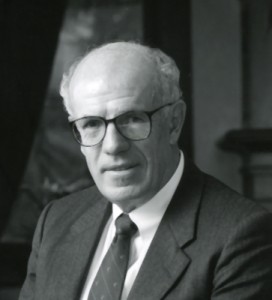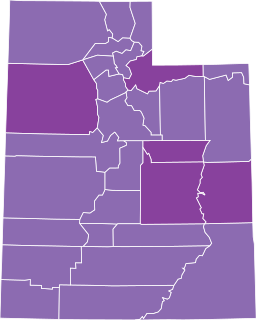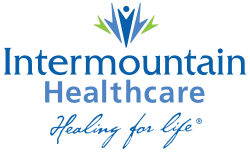Humana Inc. is a for-profit American health insurance company based in Louisville, Kentucky. In 2021, the company ranked 41 on the Fortune 500 list, which made it the highest ranked company based in Kentucky. It has been the third largest health insurance provider in the nation.

Geisinger Health System (GHS) is a regional health care provider to central, south-central and northeastern Pennsylvania. Headquartered in Danville, Pennsylvania, Geisinger services over 3 million patients in 45 counties.

Intermountain Primary Children's Hospital (PCH) is a nationally ranked pediatric acute care children's teaching hospital located in Salt Lake City, Utah. The hospital has 289 pediatric beds and is affiliated with the University of Utah School of Medicine. The hospital is a member of Intermountain Healthcare (IHC) and is the only children's hospital in the network. The hospital provides comprehensive pediatric specialties and subspecialties to infants, children, teens, and young adults aged 0–21 throughout the Salt Lake City and outer region. PCH also sometimes treats adults that require pediatric care. PCH is a ACS verified Level 1 Pediatric Trauma Center and is the largest providers of pediatric health services in the state. The hospital serves the states of Utah, Nevada, Idaho, Montana, and Wyoming, yielding an enormous geographic catchment area of approximately 400,000 square miles. The hospital is one of the only pediatric hospitals in the region.
Intermountain St. George Regional Hospital formerly Dixie Regional Medical Center (DRMC) is a 284-bed hospital located on two campuses in St. George, Utah, United States. St. George Regional is the major medical referral center for northwestern Arizona, southeastern Nevada and southern Utah. St. George Regional is fully accredited by the Joint Commission on Accreditation of Healthcare Organizations and is a service of Intermountain Healthcare, a nonprofit health care system serving the Intermountain West. It is also a Level II Trauma Center.

Utah Valley Hospital (UVH) is a 395-bed full-service tertiary and acute care referral center serving Utah County, central and southern Utah that is part of the Intermountain Healthcare system. It is a Level II Trauma Center. The name of the hospital was officially changed from Utah Valley Regional Medical Center (UVRMC).

Intermountain Medical Center is the flagship hospital of Intermountain Healthcare. Located in Murray, Utah on a 100-acre (0.40 km2) site at the center of the Salt Lake Valley, Intermountain Medical Center serves as a major adult referral center for six surrounding states and more than 75 regional health care institutions. The hospital is also a Level I trauma center, accredited by the American College of Surgeons. It has 452 beds and is accredited by the Commission on Accreditation of Rehabilitation Facilities. Intermountain Medical Center opened in October 2007, and several premature babies were transferred by Intermountain Healthcare's Life Flight to the hospital on the first day for better treatment and care.

Homer Richards Warner was an American cardiologist who was an early proponent of medical informatics who pioneered many aspects of computer applications to medicine. Author of the book, Computer-Assisted Medical Decision-Making, published in 1979, he served as CIO for the University of Utah Health Sciences Center, as president of the American College of Medical Informatics, and was actively involved with the National Institutes of Health. He was first chair of the Department of Medical Informatics at the University of Utah School of Medicine, the first American medical program to formally offer a degree in medical informatics.
An academic medical centre (AMC), variously also known as academic health science centre, academic health science system, or academic health science partnership, is an educational and healthcare institute formed by the grouping of a health professional school with an affiliated teaching hospital or hospital network.

The University of Utah Hospital is a research and teaching hospital on the campus of the University of Utah in Salt Lake City, Utah. It serves as a major regional referral center for Utah and the surrounding states of Idaho, Nevada, Wyoming, Montana and New Mexico. University of Utah Health Care is praised for the following specialties: cardiology, geriatrics, gynecology, pediatrics, rheumatology, pulmonology, neurology, oncology, orthopedics, and ophthalmology.

LDS Hospital is a general urban hospital and surgical center in Salt Lake City, Utah. The hospital was originally owned by The Church of Jesus Christ of Latter-day Saints, but is now owned and operated by Intermountain Healthcare (IHC). LDS Hospital is accredited by the Joint Commission. The hospital has 262 inpatient beds.

Sanford Health is a non-profit, integrated health care delivery system, with its headquarters in Sioux Falls, South Dakota, with additional offices in Fargo and Bismarck, North Dakota, and Bemidji, Minnesota.

The Huntsman Mental Health Institute (HMHI), formerly University Neuropsychiatric Institute (UNI), is an assemblage of psychiatric treatment, education, and research programs based in Salt Lake City, Utah. HMHI is a component of University of Utah Health Hospitals & Clinics. The institute was dedicated on 14 January 2021 after the Huntsman family, in November 2019, committed $150 million over 10 years to create the institute
William H. Nelson is an American businessman who is the former CEO of Intermountain Health Care. He received his B.S. in accounting from the Marriott School of Management, Brigham Young University, in 1967. He was also the first recipient of the National Healthcare Leadership Award.
Anshen and Allen was an international architecture, planning and design firm headquartered in San Francisco with offices in Boston, Columbus, and London. The firm was ranked eighth for sustainable practices, and nineteenth overall in the "Architect 50" published by Architect magazine in 2010. They also ranked twenty-eighth in the top "100 Giants" of Interior Design 2010.

The Mountain states form one of the nine geographic divisions of the United States that are officially recognized by the United States Census Bureau. It is a subregion of the Western United States.

Logan Regional Hospital is a 146-bed general hospital located in Logan, Utah. It is owned by Intermountain Healthcare. The hospital serves Cache Valley, including Cache County, Utah and Franklin County, Idaho, and western Wyoming. Logan Regional's mission is "Helping People Live the Healthiest Lives Possible." The hospital services include a Level III Trauma Center, Cancer Center, Women and Newborn Center, digital imaging services, and heart catheterization services. Logan Regional was named one of the United States' 100 top hospitals in 2018, marking the sixth consecutive year it has received this honor.

Reid Robison is an American board-certified psychiatrist known primarily for his work with psychedelic medicines. As an early adopter and researcher of the use of ketamine in psychiatry, Robison has made significant contributions to ketamine-assisted psychotherapy (KAP) and other treatment modalities using ketamine for mental health conditions. He previously served as coordinating investigator for a study on MDMA-assisted psychotherapy for eating disorders, sponsored by the Multidisciplinary Association for Psychedelic Studies (MAPS), and he continues to lead research and psychiatric clinical trials involving psychedelics. To date, Robison has guided thousands of ketamine-assisted therapy sessions and Spravato dosing sessions. He currently serves as Medical Director of Center for Change, an eating disorder treatment center in Utah, and Chief Clinical Officer of Numinus, a Vancouver-based mental health company focused on psychedelic research and treatments. Robison is an adjunct professor at both the University of Utah and Brigham Young University.
Karen Gail Miller is an American businesswoman. After the death of her husband Larry H. Miller, she became chairwoman of the Larry H. Miller Group of Companies. With a net worth of $1.9 billion she is the wealthiest person in Utah. She held a controlling interest in the Utah Jazz, a National Basketball Association (NBA) franchise based in Salt Lake City, Utah, from her husband's death in 2009 until selling the team in 2020. She retains a minority stake.

The COVID-19 pandemic began in the U.S. state of Utah in early March 2020 with travel-related cases. Residents stockpiled goods, large conferences were made remote-only, postponed, or cancelled; a state of emergency was declared, and some public universities and other colleges switched to online-only classes. After the first case of community spread was found on March 14, Utah faced a shortage of testing kits, and public schools were ordered to be closed. Community spread was confirmed in more counties, and the state issued a public health order prohibiting dine-in service in restaurants and gatherings of more than 10 people except in grocery stores. A 5.7-magnitude earthquake struck the Wasatch Front on March 18, 2020, hampering the pandemic response.















